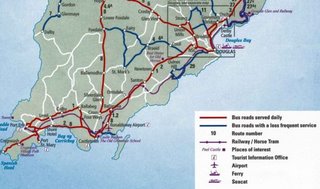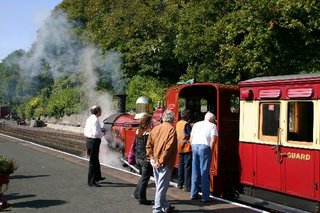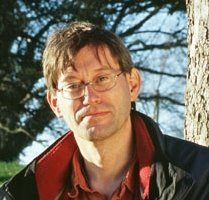Trains, sheep and cottages (the Saturday Field Trip)
 Several trips out – ours is the one going to Castletown on the Isle of Man Railway (IMR), on a steam train of course. IMR is a 3 foot gauge line which runs 2-4-0 locos dating from 1874 – it runs from Douglas to Port Erin, taking in Ballsalla, Castletown and Port St. Mary, a distance of 15.5 miles making it the longest narrow gauge steam line in Britain (well, in the British Isles). You can find out more at IoM transport heritage website , an extract of the Man transport map is shown left – full version is here.
Several trips out – ours is the one going to Castletown on the Isle of Man Railway (IMR), on a steam train of course. IMR is a 3 foot gauge line which runs 2-4-0 locos dating from 1874 – it runs from Douglas to Port Erin, taking in Ballsalla, Castletown and Port St. Mary, a distance of 15.5 miles making it the longest narrow gauge steam line in Britain (well, in the British Isles). You can find out more at IoM transport heritage website , an extract of the Man transport map is shown left – full version is here. The train is indeed small (see pic) and seems a little slow on the run to Castletown. Another group is going there by coach, and we ‘re then taking the same coach on to Cregneash. We’re not surprised to find the coach is ready and waiting, with previous occupants already out of sight, doing whatever their trip is doing.
The train is indeed small (see pic) and seems a little slow on the run to Castletown. Another group is going there by coach, and we ‘re then taking the same coach on to Cregneash. We’re not surprised to find the coach is ready and waiting, with previous occupants already out of sight, doing whatever their trip is doing.But the slow journey is very interesting – there’s an air of affluence over all the homes and farms we pass – and I’m reminded about this morning’s explanations about the Manx economy: The island is self-sufficient, makes all it’s own income, has enough to pay the UK for looking after it’s international and defence needs and still make a profit. This year they’re concerned about an economic downturn – they’re only growing by 5% - a figure most countries would be happy with – but here that’s seen as poor.
 There’s a thriving, locally-oriented agriculture business – we pass several fields of the distinctive multi-horned and somewhat ferocious-looking Loghtan Sheep and a few cows. All the butter packs we’ve seen in the hotels so far are proudly labelled IoM Creamery and even the milk in the Douglas Marks’n’Sparks is local – one wonders where all the dairy herds are – but this a big island 33 miles long and 13 wide, plenty of space for a few more cows.
There’s a thriving, locally-oriented agriculture business – we pass several fields of the distinctive multi-horned and somewhat ferocious-looking Loghtan Sheep and a few cows. All the butter packs we’ve seen in the hotels so far are proudly labelled IoM Creamery and even the milk in the Douglas Marks’n’Sparks is local – one wonders where all the dairy herds are – but this a big island 33 miles long and 13 wide, plenty of space for a few more cows. We don’t stop long in Castletown, as we’re off to Cregneash, a Living Museum owned by Manx National Heriateg (see earlier blogs for their background). MNH bought the village gradually, starting with a single cottage in 1936 – now they own all the central area and maintain the houses and farms in the traditional way.
We don’t stop long in Castletown, as we’re off to Cregneash, a Living Museum owned by Manx National Heriateg (see earlier blogs for their background). MNH bought the village gradually, starting with a single cottage in 1936 – now they own all the central area and maintain the houses and farms in the traditional way. The village looks wonderful, and it’s a shame we’re in a bit of a rush and can’t dio it justice. We start off in Ned Begs’s House – a single storey whitewash and (straw) thatch building on the edge of the site. This has recently refurbished interpretation, especially regarding Manx Gaelic – the native language of Man. Cregneash was one of the last places to hear a native Manx Speaker – and there are recordings old and new featuring Manx here. Local schoolchildren still learn it, and even have an option to be taught in it as a primary language again. More on this in the podcast…
The village looks wonderful, and it’s a shame we’re in a bit of a rush and can’t dio it justice. We start off in Ned Begs’s House – a single storey whitewash and (straw) thatch building on the edge of the site. This has recently refurbished interpretation, especially regarding Manx Gaelic – the native language of Man. Cregneash was one of the last places to hear a native Manx Speaker – and there are recordings old and new featuring Manx here. Local schoolchildren still learn it, and even have an option to be taught in it as a primary language again. More on this in the podcast… We chat with Peddyr the local site manager and he tells us that the demonstrators (weaving etc) and interpretation are currently being revised and updated – hence the new material at Ned Beg’s. His budget is limited though – and he’s had to make a few cutbacks – even museums in the affluent Isle of Man suffer like those in the UK. Some cuts are good though – he’s reduced the traditional (for the museum) annual white-washing to biennial – and the resulting slightly tatty look is much more in keeping…
We chat with Peddyr the local site manager and he tells us that the demonstrators (weaving etc) and interpretation are currently being revised and updated – hence the new material at Ned Beg’s. His budget is limited though – and he’s had to make a few cutbacks – even museums in the affluent Isle of Man suffer like those in the UK. Some cuts are good though – he’s reduced the traditional (for the museum) annual white-washing to biennial – and the resulting slightly tatty look is much more in keeping…We had to leave without seeing it all – too little time – but you can see more pictures here and hear all about it on the podcast site. This link should take you straight to this afternoon's ramblings...


0 Comments:
Post a Comment
<< Home